HI5020 Corporate Accounting: Cash Flow Statement Analysis - T1 2019
VerifiedAdded on 2023/04/03
|12
|3314
|245
Report
AI Summary
This report delves into the importance of cash flow statements in making informed business decisions, particularly for investors evaluating a company's financial stability and ability to meet short-term obligations. It examines the various sections of cash flow statements, including operating, investing, and financing activities, detailing the sources and uses of cash and cash equivalents within each section. The analysis includes a comparison of cash flow statements from different firms to determine their respective financial strengths and their capacities to repay short-term loans, with specific examples from Fantastic Ltd, Santos Ltd, and BHP Ltd. The report also covers trends in cash flow from operations, capital expenditure, dividends, net borrowing, and working capital, highlighting the difference between cash from operations and net income, and discussing the impact of working capital on cash flows. Ultimately, the report aims to provide a comprehensive understanding of how cash flow statements can be used to assess a company's financial health and investment potential.
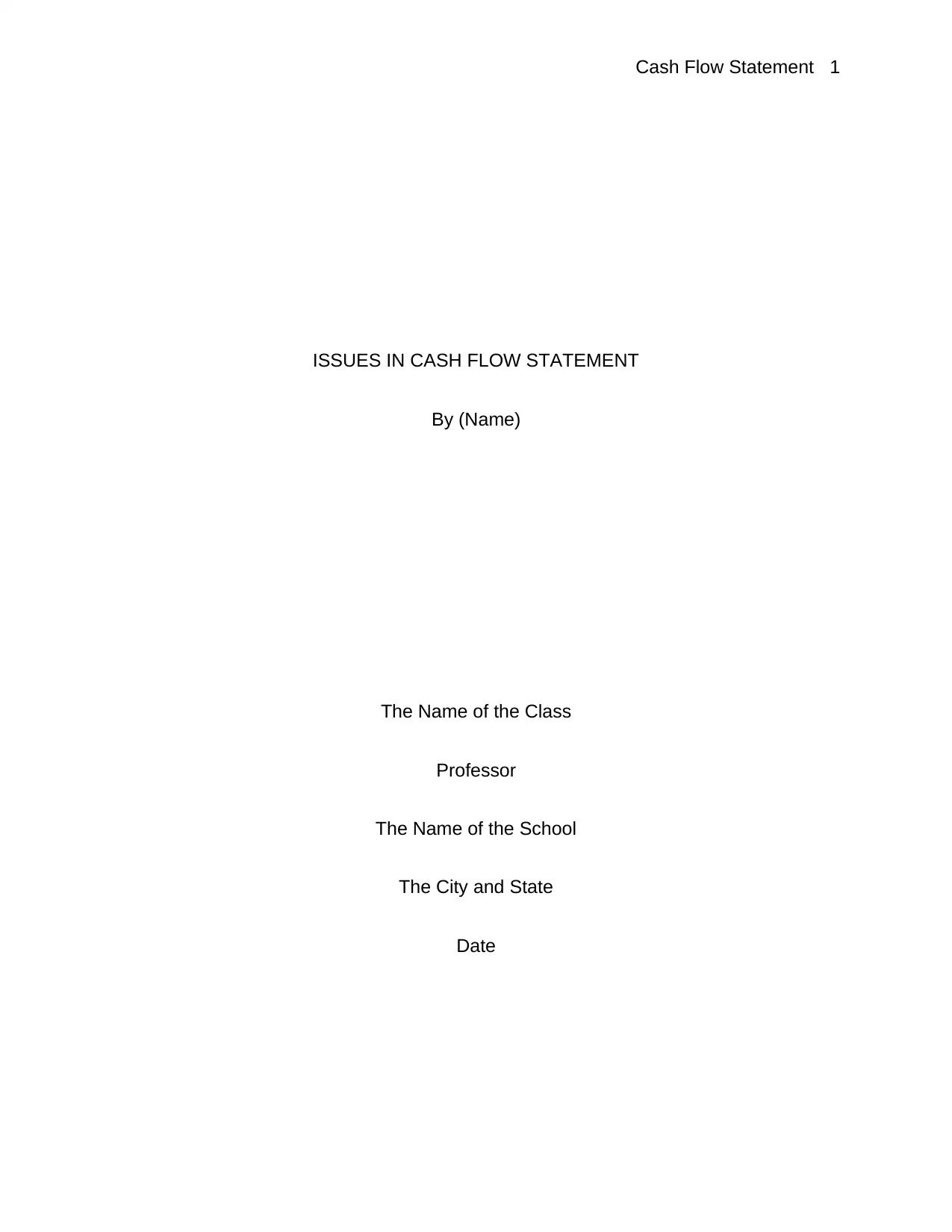
Cash Flow Statement 1
ISSUES IN CASH FLOW STATEMENT
By (Name)
The Name of the Class
Professor
The Name of the School
The City and State
Date
ISSUES IN CASH FLOW STATEMENT
By (Name)
The Name of the Class
Professor
The Name of the School
The City and State
Date
Paraphrase This Document
Need a fresh take? Get an instant paraphrase of this document with our AI Paraphraser
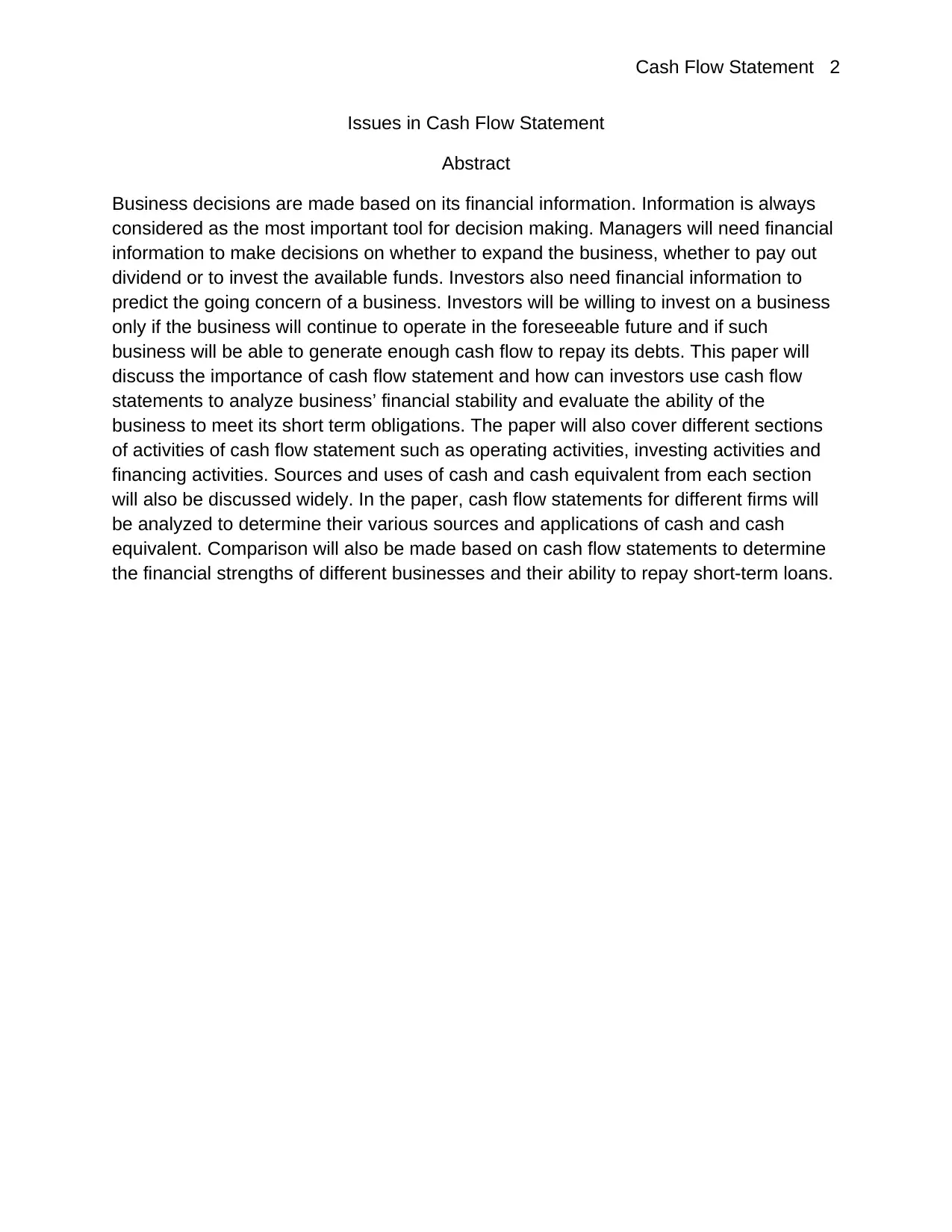
Cash Flow Statement 2
Issues in Cash Flow Statement
Abstract
Business decisions are made based on its financial information. Information is always
considered as the most important tool for decision making. Managers will need financial
information to make decisions on whether to expand the business, whether to pay out
dividend or to invest the available funds. Investors also need financial information to
predict the going concern of a business. Investors will be willing to invest on a business
only if the business will continue to operate in the foreseeable future and if such
business will be able to generate enough cash flow to repay its debts. This paper will
discuss the importance of cash flow statement and how can investors use cash flow
statements to analyze business’ financial stability and evaluate the ability of the
business to meet its short term obligations. The paper will also cover different sections
of activities of cash flow statement such as operating activities, investing activities and
financing activities. Sources and uses of cash and cash equivalent from each section
will also be discussed widely. In the paper, cash flow statements for different firms will
be analyzed to determine their various sources and applications of cash and cash
equivalent. Comparison will also be made based on cash flow statements to determine
the financial strengths of different businesses and their ability to repay short-term loans.
Issues in Cash Flow Statement
Abstract
Business decisions are made based on its financial information. Information is always
considered as the most important tool for decision making. Managers will need financial
information to make decisions on whether to expand the business, whether to pay out
dividend or to invest the available funds. Investors also need financial information to
predict the going concern of a business. Investors will be willing to invest on a business
only if the business will continue to operate in the foreseeable future and if such
business will be able to generate enough cash flow to repay its debts. This paper will
discuss the importance of cash flow statement and how can investors use cash flow
statements to analyze business’ financial stability and evaluate the ability of the
business to meet its short term obligations. The paper will also cover different sections
of activities of cash flow statement such as operating activities, investing activities and
financing activities. Sources and uses of cash and cash equivalent from each section
will also be discussed widely. In the paper, cash flow statements for different firms will
be analyzed to determine their various sources and applications of cash and cash
equivalent. Comparison will also be made based on cash flow statements to determine
the financial strengths of different businesses and their ability to repay short-term loans.
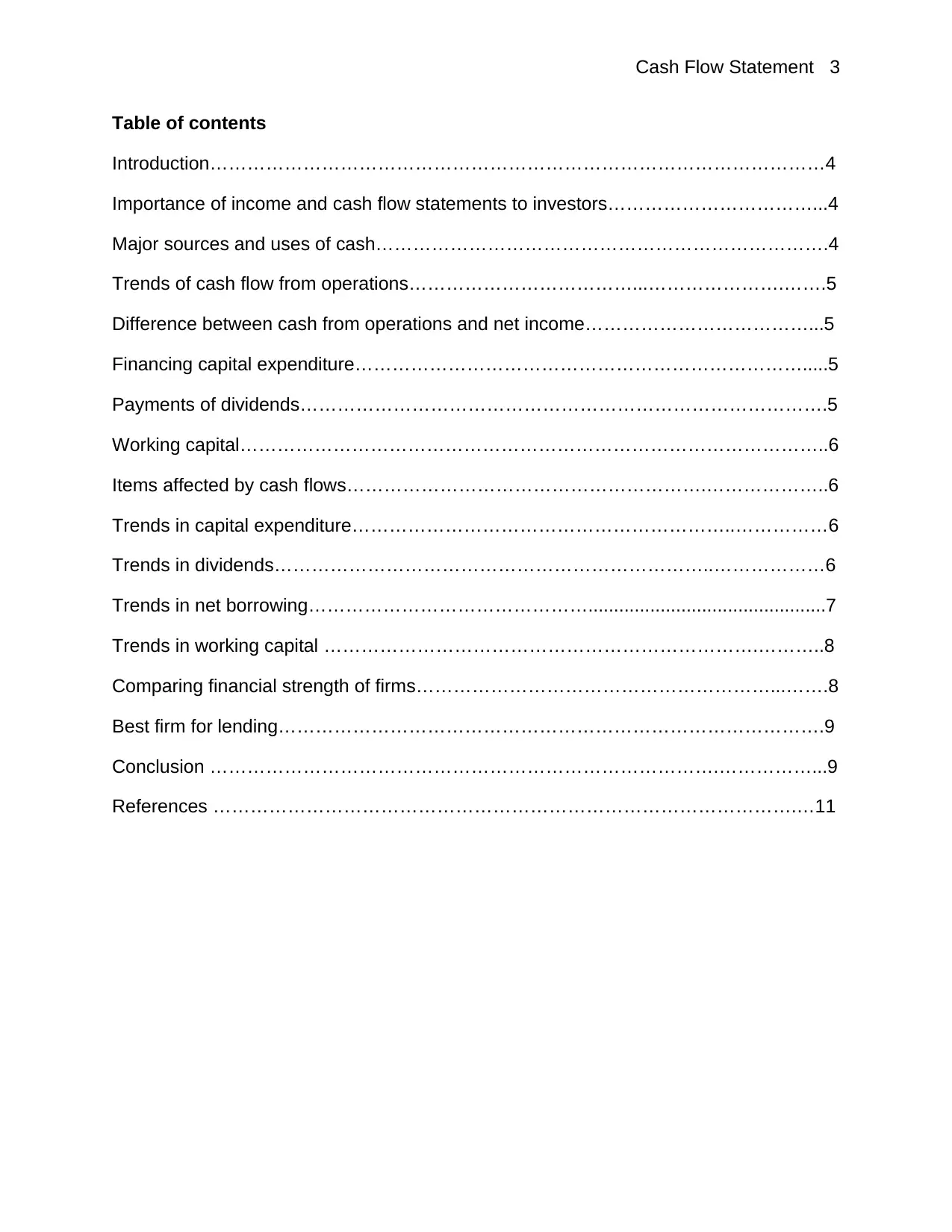
Cash Flow Statement 3
Table of contents
Introduction………………………………………………………………………………………4
Importance of income and cash flow statements to investors……………………………...4
Major sources and uses of cash……………………………………………………………….4
Trends of cash flow from operations………………………………...………………….…….5
Difference between cash from operations and net income………………………………...5
Financing capital expenditure……………………………………………………………….....5
Payments of dividends………………………………………………………………………….5
Working capital…………………………………………………………………………………..6
Items affected by cash flows………………………………………………….………………..6
Trends in capital expenditure……………………………………………………..……………6
Trends in dividends……………………………………………………………..………………6
Trends in net borrowing………………………………………..............................................7
Trends in working capital …………………………………………………………….………..8
Comparing financial strength of firms…………………………………………………...…….8
Best firm for lending…………………………………………………………………………….9
Conclusion ……………………………………………………………………….……………...9
References ………………………………………………………………………………….…11
Table of contents
Introduction………………………………………………………………………………………4
Importance of income and cash flow statements to investors……………………………...4
Major sources and uses of cash……………………………………………………………….4
Trends of cash flow from operations………………………………...………………….…….5
Difference between cash from operations and net income………………………………...5
Financing capital expenditure……………………………………………………………….....5
Payments of dividends………………………………………………………………………….5
Working capital…………………………………………………………………………………..6
Items affected by cash flows………………………………………………….………………..6
Trends in capital expenditure……………………………………………………..……………6
Trends in dividends……………………………………………………………..………………6
Trends in net borrowing………………………………………..............................................7
Trends in working capital …………………………………………………………….………..8
Comparing financial strength of firms…………………………………………………...…….8
Best firm for lending…………………………………………………………………………….9
Conclusion ……………………………………………………………………….……………...9
References ………………………………………………………………………………….…11
⊘ This is a preview!⊘
Do you want full access?
Subscribe today to unlock all pages.

Trusted by 1+ million students worldwide
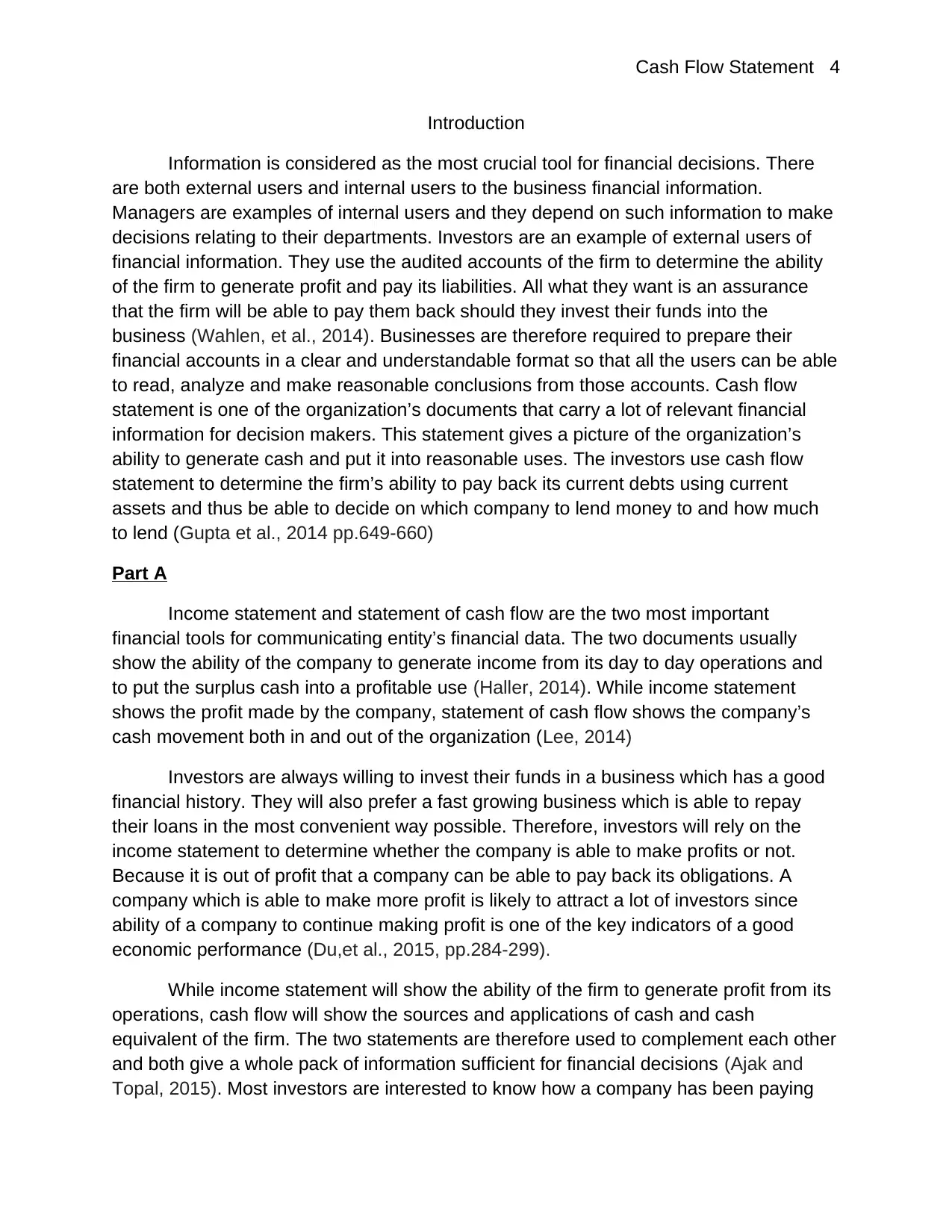
Cash Flow Statement 4
Introduction
Information is considered as the most crucial tool for financial decisions. There
are both external users and internal users to the business financial information.
Managers are examples of internal users and they depend on such information to make
decisions relating to their departments. Investors are an example of external users of
financial information. They use the audited accounts of the firm to determine the ability
of the firm to generate profit and pay its liabilities. All what they want is an assurance
that the firm will be able to pay them back should they invest their funds into the
business (Wahlen, et al., 2014). Businesses are therefore required to prepare their
financial accounts in a clear and understandable format so that all the users can be able
to read, analyze and make reasonable conclusions from those accounts. Cash flow
statement is one of the organization’s documents that carry a lot of relevant financial
information for decision makers. This statement gives a picture of the organization’s
ability to generate cash and put it into reasonable uses. The investors use cash flow
statement to determine the firm’s ability to pay back its current debts using current
assets and thus be able to decide on which company to lend money to and how much
to lend (Gupta et al., 2014 pp.649-660)
Part A
Income statement and statement of cash flow are the two most important
financial tools for communicating entity’s financial data. The two documents usually
show the ability of the company to generate income from its day to day operations and
to put the surplus cash into a profitable use (Haller, 2014). While income statement
shows the profit made by the company, statement of cash flow shows the company’s
cash movement both in and out of the organization (Lee, 2014)
Investors are always willing to invest their funds in a business which has a good
financial history. They will also prefer a fast growing business which is able to repay
their loans in the most convenient way possible. Therefore, investors will rely on the
income statement to determine whether the company is able to make profits or not.
Because it is out of profit that a company can be able to pay back its obligations. A
company which is able to make more profit is likely to attract a lot of investors since
ability of a company to continue making profit is one of the key indicators of a good
economic performance (Du,et al., 2015, pp.284-299).
While income statement will show the ability of the firm to generate profit from its
operations, cash flow will show the sources and applications of cash and cash
equivalent of the firm. The two statements are therefore used to complement each other
and both give a whole pack of information sufficient for financial decisions (Ajak and
Topal, 2015). Most investors are interested to know how a company has been paying
Introduction
Information is considered as the most crucial tool for financial decisions. There
are both external users and internal users to the business financial information.
Managers are examples of internal users and they depend on such information to make
decisions relating to their departments. Investors are an example of external users of
financial information. They use the audited accounts of the firm to determine the ability
of the firm to generate profit and pay its liabilities. All what they want is an assurance
that the firm will be able to pay them back should they invest their funds into the
business (Wahlen, et al., 2014). Businesses are therefore required to prepare their
financial accounts in a clear and understandable format so that all the users can be able
to read, analyze and make reasonable conclusions from those accounts. Cash flow
statement is one of the organization’s documents that carry a lot of relevant financial
information for decision makers. This statement gives a picture of the organization’s
ability to generate cash and put it into reasonable uses. The investors use cash flow
statement to determine the firm’s ability to pay back its current debts using current
assets and thus be able to decide on which company to lend money to and how much
to lend (Gupta et al., 2014 pp.649-660)
Part A
Income statement and statement of cash flow are the two most important
financial tools for communicating entity’s financial data. The two documents usually
show the ability of the company to generate income from its day to day operations and
to put the surplus cash into a profitable use (Haller, 2014). While income statement
shows the profit made by the company, statement of cash flow shows the company’s
cash movement both in and out of the organization (Lee, 2014)
Investors are always willing to invest their funds in a business which has a good
financial history. They will also prefer a fast growing business which is able to repay
their loans in the most convenient way possible. Therefore, investors will rely on the
income statement to determine whether the company is able to make profits or not.
Because it is out of profit that a company can be able to pay back its obligations. A
company which is able to make more profit is likely to attract a lot of investors since
ability of a company to continue making profit is one of the key indicators of a good
economic performance (Du,et al., 2015, pp.284-299).
While income statement will show the ability of the firm to generate profit from its
operations, cash flow will show the sources and applications of cash and cash
equivalent of the firm. The two statements are therefore used to complement each other
and both give a whole pack of information sufficient for financial decisions (Ajak and
Topal, 2015). Most investors are interested to know how a company has been paying
Paraphrase This Document
Need a fresh take? Get an instant paraphrase of this document with our AI Paraphraser
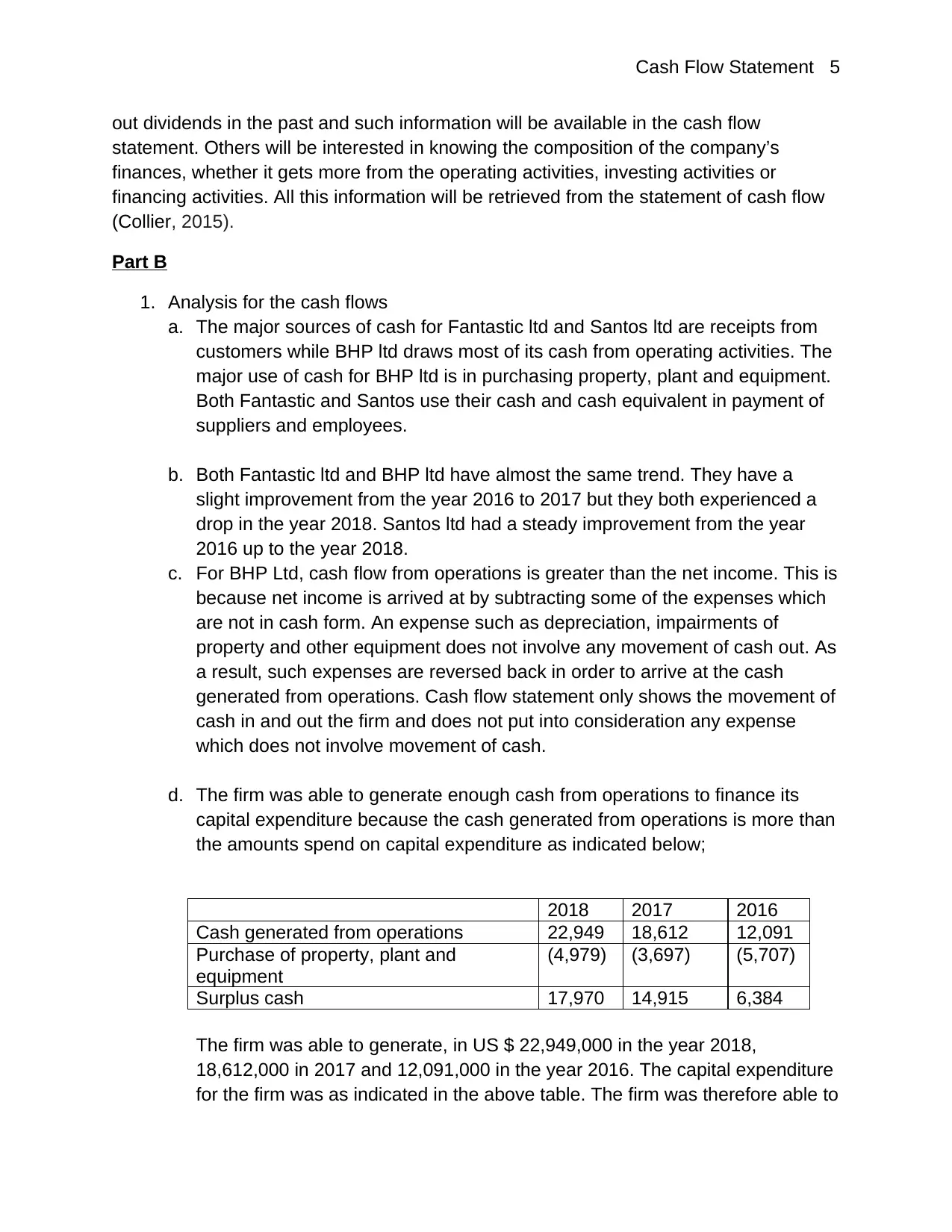
Cash Flow Statement 5
out dividends in the past and such information will be available in the cash flow
statement. Others will be interested in knowing the composition of the company’s
finances, whether it gets more from the operating activities, investing activities or
financing activities. All this information will be retrieved from the statement of cash flow
(Collier, 2015).
Part B
1. Analysis for the cash flows
a. The major sources of cash for Fantastic ltd and Santos ltd are receipts from
customers while BHP ltd draws most of its cash from operating activities. The
major use of cash for BHP ltd is in purchasing property, plant and equipment.
Both Fantastic and Santos use their cash and cash equivalent in payment of
suppliers and employees.
b. Both Fantastic ltd and BHP ltd have almost the same trend. They have a
slight improvement from the year 2016 to 2017 but they both experienced a
drop in the year 2018. Santos ltd had a steady improvement from the year
2016 up to the year 2018.
c. For BHP Ltd, cash flow from operations is greater than the net income. This is
because net income is arrived at by subtracting some of the expenses which
are not in cash form. An expense such as depreciation, impairments of
property and other equipment does not involve any movement of cash out. As
a result, such expenses are reversed back in order to arrive at the cash
generated from operations. Cash flow statement only shows the movement of
cash in and out the firm and does not put into consideration any expense
which does not involve movement of cash.
d. The firm was able to generate enough cash from operations to finance its
capital expenditure because the cash generated from operations is more than
the amounts spend on capital expenditure as indicated below;
2018 2017 2016
Cash generated from operations 22,949 18,612 12,091
Purchase of property, plant and
equipment
(4,979) (3,697) (5,707)
Surplus cash 17,970 14,915 6,384
The firm was able to generate, in US $ 22,949,000 in the year 2018,
18,612,000 in 2017 and 12,091,000 in the year 2016. The capital expenditure
for the firm was as indicated in the above table. The firm was therefore able to
out dividends in the past and such information will be available in the cash flow
statement. Others will be interested in knowing the composition of the company’s
finances, whether it gets more from the operating activities, investing activities or
financing activities. All this information will be retrieved from the statement of cash flow
(Collier, 2015).
Part B
1. Analysis for the cash flows
a. The major sources of cash for Fantastic ltd and Santos ltd are receipts from
customers while BHP ltd draws most of its cash from operating activities. The
major use of cash for BHP ltd is in purchasing property, plant and equipment.
Both Fantastic and Santos use their cash and cash equivalent in payment of
suppliers and employees.
b. Both Fantastic ltd and BHP ltd have almost the same trend. They have a
slight improvement from the year 2016 to 2017 but they both experienced a
drop in the year 2018. Santos ltd had a steady improvement from the year
2016 up to the year 2018.
c. For BHP Ltd, cash flow from operations is greater than the net income. This is
because net income is arrived at by subtracting some of the expenses which
are not in cash form. An expense such as depreciation, impairments of
property and other equipment does not involve any movement of cash out. As
a result, such expenses are reversed back in order to arrive at the cash
generated from operations. Cash flow statement only shows the movement of
cash in and out the firm and does not put into consideration any expense
which does not involve movement of cash.
d. The firm was able to generate enough cash from operations to finance its
capital expenditure because the cash generated from operations is more than
the amounts spend on capital expenditure as indicated below;
2018 2017 2016
Cash generated from operations 22,949 18,612 12,091
Purchase of property, plant and
equipment
(4,979) (3,697) (5,707)
Surplus cash 17,970 14,915 6,384
The firm was able to generate, in US $ 22,949,000 in the year 2018,
18,612,000 in 2017 and 12,091,000 in the year 2016. The capital expenditure
for the firm was as indicated in the above table. The firm was therefore able to
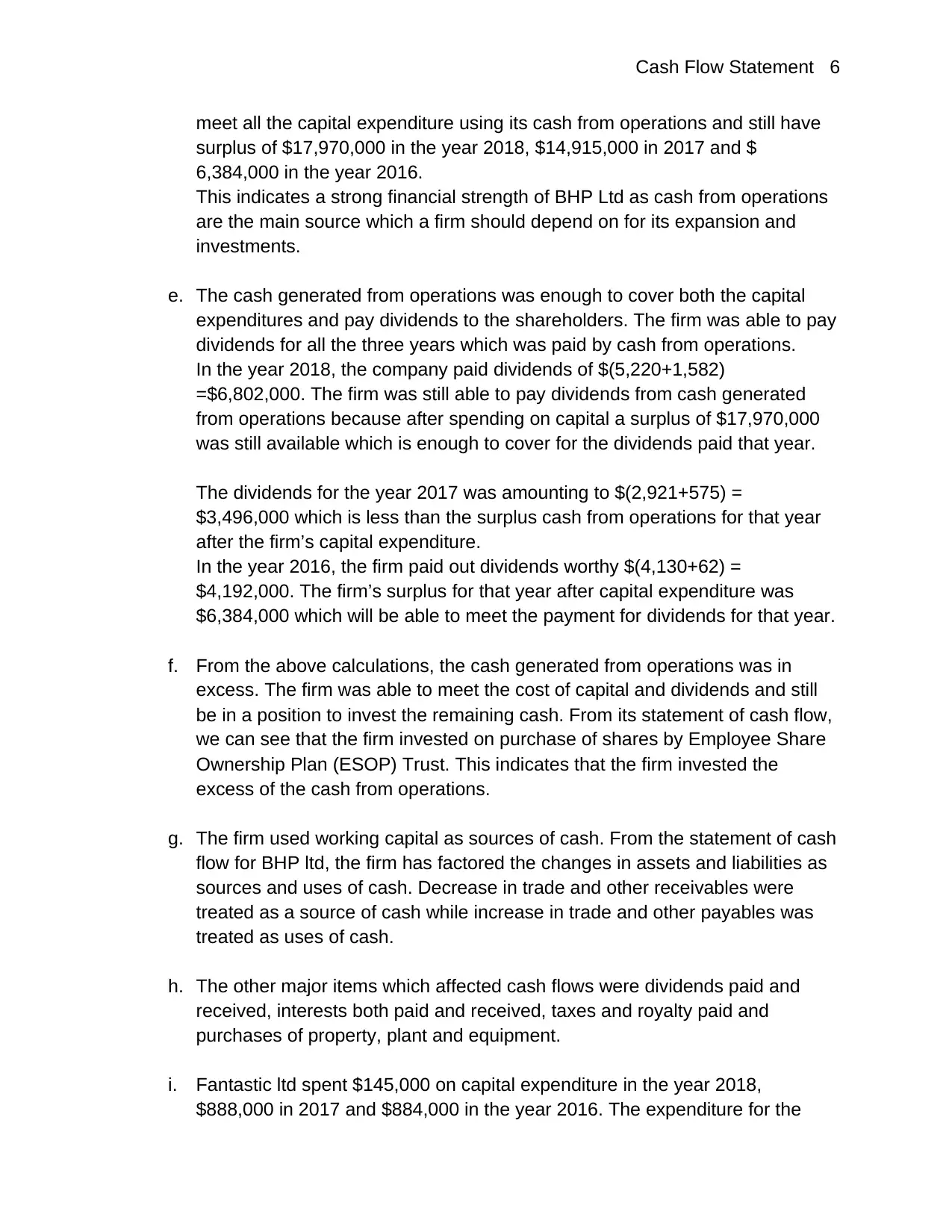
Cash Flow Statement 6
meet all the capital expenditure using its cash from operations and still have
surplus of $17,970,000 in the year 2018, $14,915,000 in 2017 and $
6,384,000 in the year 2016.
This indicates a strong financial strength of BHP Ltd as cash from operations
are the main source which a firm should depend on for its expansion and
investments.
e. The cash generated from operations was enough to cover both the capital
expenditures and pay dividends to the shareholders. The firm was able to pay
dividends for all the three years which was paid by cash from operations.
In the year 2018, the company paid dividends of $(5,220+1,582)
=$6,802,000. The firm was still able to pay dividends from cash generated
from operations because after spending on capital a surplus of $17,970,000
was still available which is enough to cover for the dividends paid that year.
The dividends for the year 2017 was amounting to $(2,921+575) =
$3,496,000 which is less than the surplus cash from operations for that year
after the firm’s capital expenditure.
In the year 2016, the firm paid out dividends worthy $(4,130+62) =
$4,192,000. The firm’s surplus for that year after capital expenditure was
$6,384,000 which will be able to meet the payment for dividends for that year.
f. From the above calculations, the cash generated from operations was in
excess. The firm was able to meet the cost of capital and dividends and still
be in a position to invest the remaining cash. From its statement of cash flow,
we can see that the firm invested on purchase of shares by Employee Share
Ownership Plan (ESOP) Trust. This indicates that the firm invested the
excess of the cash from operations.
g. The firm used working capital as sources of cash. From the statement of cash
flow for BHP ltd, the firm has factored the changes in assets and liabilities as
sources and uses of cash. Decrease in trade and other receivables were
treated as a source of cash while increase in trade and other payables was
treated as uses of cash.
h. The other major items which affected cash flows were dividends paid and
received, interests both paid and received, taxes and royalty paid and
purchases of property, plant and equipment.
i. Fantastic ltd spent $145,000 on capital expenditure in the year 2018,
$888,000 in 2017 and $884,000 in the year 2016. The expenditure for the
meet all the capital expenditure using its cash from operations and still have
surplus of $17,970,000 in the year 2018, $14,915,000 in 2017 and $
6,384,000 in the year 2016.
This indicates a strong financial strength of BHP Ltd as cash from operations
are the main source which a firm should depend on for its expansion and
investments.
e. The cash generated from operations was enough to cover both the capital
expenditures and pay dividends to the shareholders. The firm was able to pay
dividends for all the three years which was paid by cash from operations.
In the year 2018, the company paid dividends of $(5,220+1,582)
=$6,802,000. The firm was still able to pay dividends from cash generated
from operations because after spending on capital a surplus of $17,970,000
was still available which is enough to cover for the dividends paid that year.
The dividends for the year 2017 was amounting to $(2,921+575) =
$3,496,000 which is less than the surplus cash from operations for that year
after the firm’s capital expenditure.
In the year 2016, the firm paid out dividends worthy $(4,130+62) =
$4,192,000. The firm’s surplus for that year after capital expenditure was
$6,384,000 which will be able to meet the payment for dividends for that year.
f. From the above calculations, the cash generated from operations was in
excess. The firm was able to meet the cost of capital and dividends and still
be in a position to invest the remaining cash. From its statement of cash flow,
we can see that the firm invested on purchase of shares by Employee Share
Ownership Plan (ESOP) Trust. This indicates that the firm invested the
excess of the cash from operations.
g. The firm used working capital as sources of cash. From the statement of cash
flow for BHP ltd, the firm has factored the changes in assets and liabilities as
sources and uses of cash. Decrease in trade and other receivables were
treated as a source of cash while increase in trade and other payables was
treated as uses of cash.
h. The other major items which affected cash flows were dividends paid and
received, interests both paid and received, taxes and royalty paid and
purchases of property, plant and equipment.
i. Fantastic ltd spent $145,000 on capital expenditure in the year 2018,
$888,000 in 2017 and $884,000 in the year 2016. The expenditure for the
⊘ This is a preview!⊘
Do you want full access?
Subscribe today to unlock all pages.

Trusted by 1+ million students worldwide
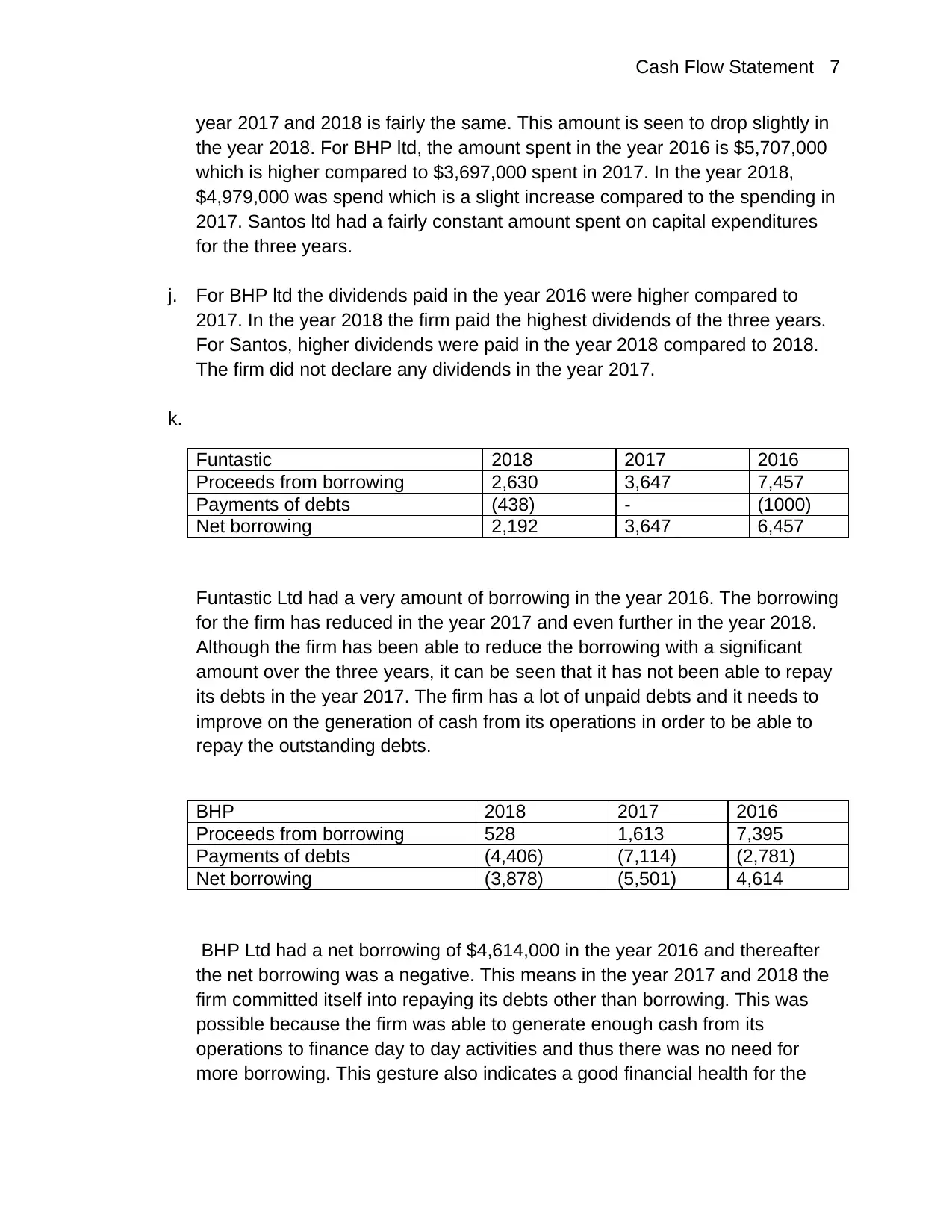
Cash Flow Statement 7
year 2017 and 2018 is fairly the same. This amount is seen to drop slightly in
the year 2018. For BHP ltd, the amount spent in the year 2016 is $5,707,000
which is higher compared to $3,697,000 spent in 2017. In the year 2018,
$4,979,000 was spend which is a slight increase compared to the spending in
2017. Santos ltd had a fairly constant amount spent on capital expenditures
for the three years.
j. For BHP ltd the dividends paid in the year 2016 were higher compared to
2017. In the year 2018 the firm paid the highest dividends of the three years.
For Santos, higher dividends were paid in the year 2018 compared to 2018.
The firm did not declare any dividends in the year 2017.
k.
Funtastic 2018 2017 2016
Proceeds from borrowing 2,630 3,647 7,457
Payments of debts (438) - (1000)
Net borrowing 2,192 3,647 6,457
Funtastic Ltd had a very amount of borrowing in the year 2016. The borrowing
for the firm has reduced in the year 2017 and even further in the year 2018.
Although the firm has been able to reduce the borrowing with a significant
amount over the three years, it can be seen that it has not been able to repay
its debts in the year 2017. The firm has a lot of unpaid debts and it needs to
improve on the generation of cash from its operations in order to be able to
repay the outstanding debts.
BHP 2018 2017 2016
Proceeds from borrowing 528 1,613 7,395
Payments of debts (4,406) (7,114) (2,781)
Net borrowing (3,878) (5,501) 4,614
BHP Ltd had a net borrowing of $4,614,000 in the year 2016 and thereafter
the net borrowing was a negative. This means in the year 2017 and 2018 the
firm committed itself into repaying its debts other than borrowing. This was
possible because the firm was able to generate enough cash from its
operations to finance day to day activities and thus there was no need for
more borrowing. This gesture also indicates a good financial health for the
year 2017 and 2018 is fairly the same. This amount is seen to drop slightly in
the year 2018. For BHP ltd, the amount spent in the year 2016 is $5,707,000
which is higher compared to $3,697,000 spent in 2017. In the year 2018,
$4,979,000 was spend which is a slight increase compared to the spending in
2017. Santos ltd had a fairly constant amount spent on capital expenditures
for the three years.
j. For BHP ltd the dividends paid in the year 2016 were higher compared to
2017. In the year 2018 the firm paid the highest dividends of the three years.
For Santos, higher dividends were paid in the year 2018 compared to 2018.
The firm did not declare any dividends in the year 2017.
k.
Funtastic 2018 2017 2016
Proceeds from borrowing 2,630 3,647 7,457
Payments of debts (438) - (1000)
Net borrowing 2,192 3,647 6,457
Funtastic Ltd had a very amount of borrowing in the year 2016. The borrowing
for the firm has reduced in the year 2017 and even further in the year 2018.
Although the firm has been able to reduce the borrowing with a significant
amount over the three years, it can be seen that it has not been able to repay
its debts in the year 2017. The firm has a lot of unpaid debts and it needs to
improve on the generation of cash from its operations in order to be able to
repay the outstanding debts.
BHP 2018 2017 2016
Proceeds from borrowing 528 1,613 7,395
Payments of debts (4,406) (7,114) (2,781)
Net borrowing (3,878) (5,501) 4,614
BHP Ltd had a net borrowing of $4,614,000 in the year 2016 and thereafter
the net borrowing was a negative. This means in the year 2017 and 2018 the
firm committed itself into repaying its debts other than borrowing. This was
possible because the firm was able to generate enough cash from its
operations to finance day to day activities and thus there was no need for
more borrowing. This gesture also indicates a good financial health for the
Paraphrase This Document
Need a fresh take? Get an instant paraphrase of this document with our AI Paraphraser
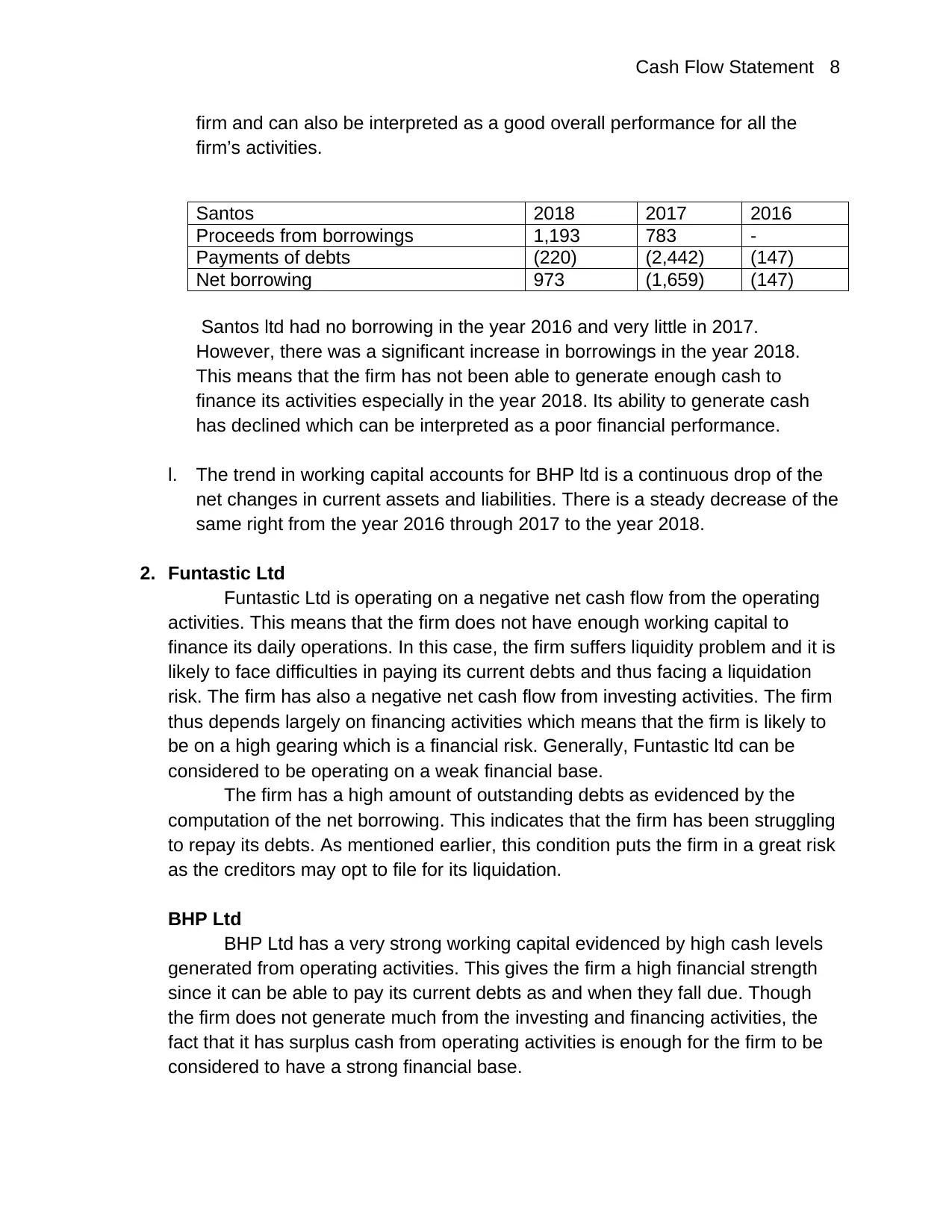
Cash Flow Statement 8
firm and can also be interpreted as a good overall performance for all the
firm’s activities.
Santos 2018 2017 2016
Proceeds from borrowings 1,193 783 -
Payments of debts (220) (2,442) (147)
Net borrowing 973 (1,659) (147)
Santos ltd had no borrowing in the year 2016 and very little in 2017.
However, there was a significant increase in borrowings in the year 2018.
This means that the firm has not been able to generate enough cash to
finance its activities especially in the year 2018. Its ability to generate cash
has declined which can be interpreted as a poor financial performance.
l. The trend in working capital accounts for BHP ltd is a continuous drop of the
net changes in current assets and liabilities. There is a steady decrease of the
same right from the year 2016 through 2017 to the year 2018.
2. Funtastic Ltd
Funtastic Ltd is operating on a negative net cash flow from the operating
activities. This means that the firm does not have enough working capital to
finance its daily operations. In this case, the firm suffers liquidity problem and it is
likely to face difficulties in paying its current debts and thus facing a liquidation
risk. The firm has also a negative net cash flow from investing activities. The firm
thus depends largely on financing activities which means that the firm is likely to
be on a high gearing which is a financial risk. Generally, Funtastic ltd can be
considered to be operating on a weak financial base.
The firm has a high amount of outstanding debts as evidenced by the
computation of the net borrowing. This indicates that the firm has been struggling
to repay its debts. As mentioned earlier, this condition puts the firm in a great risk
as the creditors may opt to file for its liquidation.
BHP Ltd
BHP Ltd has a very strong working capital evidenced by high cash levels
generated from operating activities. This gives the firm a high financial strength
since it can be able to pay its current debts as and when they fall due. Though
the firm does not generate much from the investing and financing activities, the
fact that it has surplus cash from operating activities is enough for the firm to be
considered to have a strong financial base.
firm and can also be interpreted as a good overall performance for all the
firm’s activities.
Santos 2018 2017 2016
Proceeds from borrowings 1,193 783 -
Payments of debts (220) (2,442) (147)
Net borrowing 973 (1,659) (147)
Santos ltd had no borrowing in the year 2016 and very little in 2017.
However, there was a significant increase in borrowings in the year 2018.
This means that the firm has not been able to generate enough cash to
finance its activities especially in the year 2018. Its ability to generate cash
has declined which can be interpreted as a poor financial performance.
l. The trend in working capital accounts for BHP ltd is a continuous drop of the
net changes in current assets and liabilities. There is a steady decrease of the
same right from the year 2016 through 2017 to the year 2018.
2. Funtastic Ltd
Funtastic Ltd is operating on a negative net cash flow from the operating
activities. This means that the firm does not have enough working capital to
finance its daily operations. In this case, the firm suffers liquidity problem and it is
likely to face difficulties in paying its current debts and thus facing a liquidation
risk. The firm has also a negative net cash flow from investing activities. The firm
thus depends largely on financing activities which means that the firm is likely to
be on a high gearing which is a financial risk. Generally, Funtastic ltd can be
considered to be operating on a weak financial base.
The firm has a high amount of outstanding debts as evidenced by the
computation of the net borrowing. This indicates that the firm has been struggling
to repay its debts. As mentioned earlier, this condition puts the firm in a great risk
as the creditors may opt to file for its liquidation.
BHP Ltd
BHP Ltd has a very strong working capital evidenced by high cash levels
generated from operating activities. This gives the firm a high financial strength
since it can be able to pay its current debts as and when they fall due. Though
the firm does not generate much from the investing and financing activities, the
fact that it has surplus cash from operating activities is enough for the firm to be
considered to have a strong financial base.
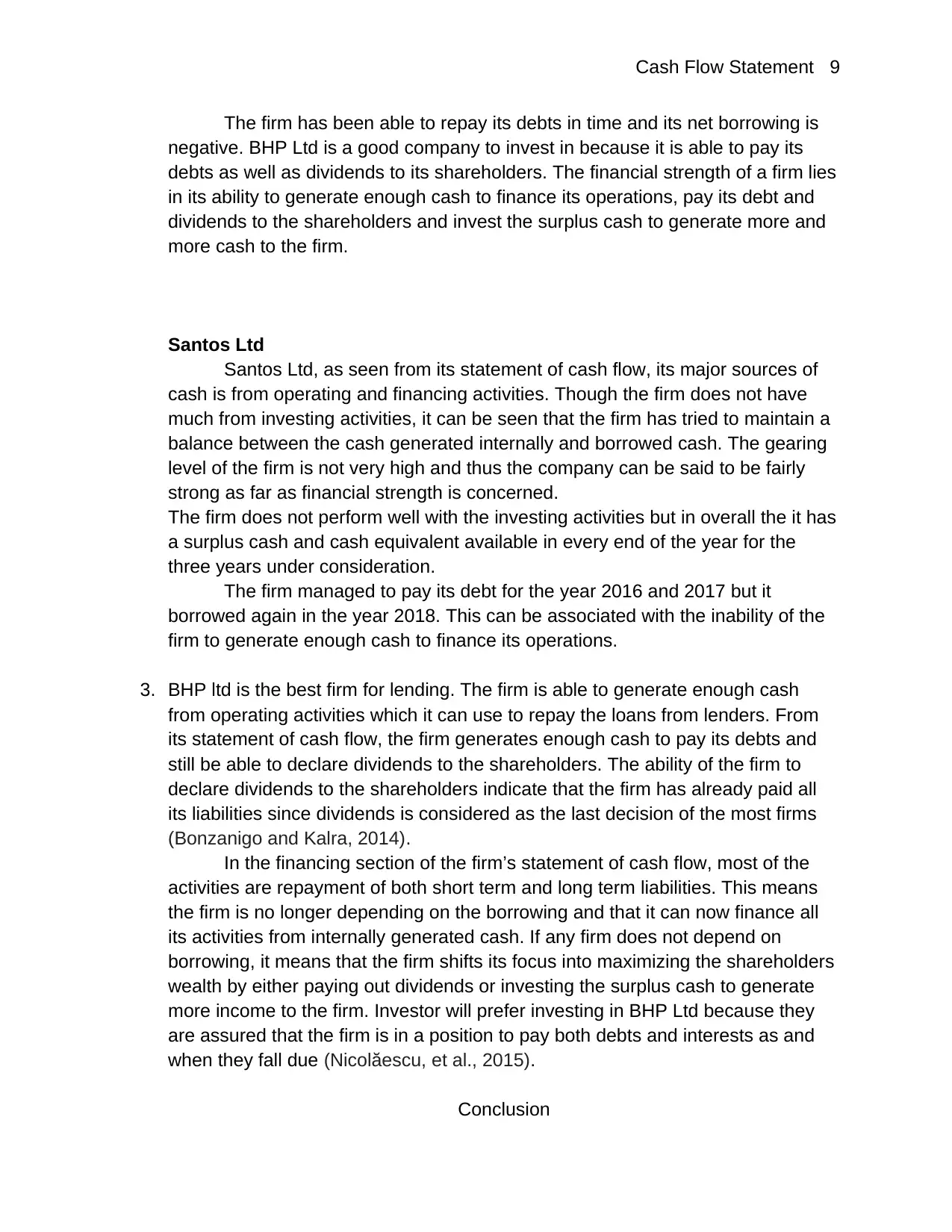
Cash Flow Statement 9
The firm has been able to repay its debts in time and its net borrowing is
negative. BHP Ltd is a good company to invest in because it is able to pay its
debts as well as dividends to its shareholders. The financial strength of a firm lies
in its ability to generate enough cash to finance its operations, pay its debt and
dividends to the shareholders and invest the surplus cash to generate more and
more cash to the firm.
Santos Ltd
Santos Ltd, as seen from its statement of cash flow, its major sources of
cash is from operating and financing activities. Though the firm does not have
much from investing activities, it can be seen that the firm has tried to maintain a
balance between the cash generated internally and borrowed cash. The gearing
level of the firm is not very high and thus the company can be said to be fairly
strong as far as financial strength is concerned.
The firm does not perform well with the investing activities but in overall the it has
a surplus cash and cash equivalent available in every end of the year for the
three years under consideration.
The firm managed to pay its debt for the year 2016 and 2017 but it
borrowed again in the year 2018. This can be associated with the inability of the
firm to generate enough cash to finance its operations.
3. BHP ltd is the best firm for lending. The firm is able to generate enough cash
from operating activities which it can use to repay the loans from lenders. From
its statement of cash flow, the firm generates enough cash to pay its debts and
still be able to declare dividends to the shareholders. The ability of the firm to
declare dividends to the shareholders indicate that the firm has already paid all
its liabilities since dividends is considered as the last decision of the most firms
(Bonzanigo and Kalra, 2014).
In the financing section of the firm’s statement of cash flow, most of the
activities are repayment of both short term and long term liabilities. This means
the firm is no longer depending on the borrowing and that it can now finance all
its activities from internally generated cash. If any firm does not depend on
borrowing, it means that the firm shifts its focus into maximizing the shareholders
wealth by either paying out dividends or investing the surplus cash to generate
more income to the firm. Investor will prefer investing in BHP Ltd because they
are assured that the firm is in a position to pay both debts and interests as and
when they fall due (Nicolăescu, et al., 2015).
Conclusion
The firm has been able to repay its debts in time and its net borrowing is
negative. BHP Ltd is a good company to invest in because it is able to pay its
debts as well as dividends to its shareholders. The financial strength of a firm lies
in its ability to generate enough cash to finance its operations, pay its debt and
dividends to the shareholders and invest the surplus cash to generate more and
more cash to the firm.
Santos Ltd
Santos Ltd, as seen from its statement of cash flow, its major sources of
cash is from operating and financing activities. Though the firm does not have
much from investing activities, it can be seen that the firm has tried to maintain a
balance between the cash generated internally and borrowed cash. The gearing
level of the firm is not very high and thus the company can be said to be fairly
strong as far as financial strength is concerned.
The firm does not perform well with the investing activities but in overall the it has
a surplus cash and cash equivalent available in every end of the year for the
three years under consideration.
The firm managed to pay its debt for the year 2016 and 2017 but it
borrowed again in the year 2018. This can be associated with the inability of the
firm to generate enough cash to finance its operations.
3. BHP ltd is the best firm for lending. The firm is able to generate enough cash
from operating activities which it can use to repay the loans from lenders. From
its statement of cash flow, the firm generates enough cash to pay its debts and
still be able to declare dividends to the shareholders. The ability of the firm to
declare dividends to the shareholders indicate that the firm has already paid all
its liabilities since dividends is considered as the last decision of the most firms
(Bonzanigo and Kalra, 2014).
In the financing section of the firm’s statement of cash flow, most of the
activities are repayment of both short term and long term liabilities. This means
the firm is no longer depending on the borrowing and that it can now finance all
its activities from internally generated cash. If any firm does not depend on
borrowing, it means that the firm shifts its focus into maximizing the shareholders
wealth by either paying out dividends or investing the surplus cash to generate
more income to the firm. Investor will prefer investing in BHP Ltd because they
are assured that the firm is in a position to pay both debts and interests as and
when they fall due (Nicolăescu, et al., 2015).
Conclusion
⊘ This is a preview!⊘
Do you want full access?
Subscribe today to unlock all pages.

Trusted by 1+ million students worldwide
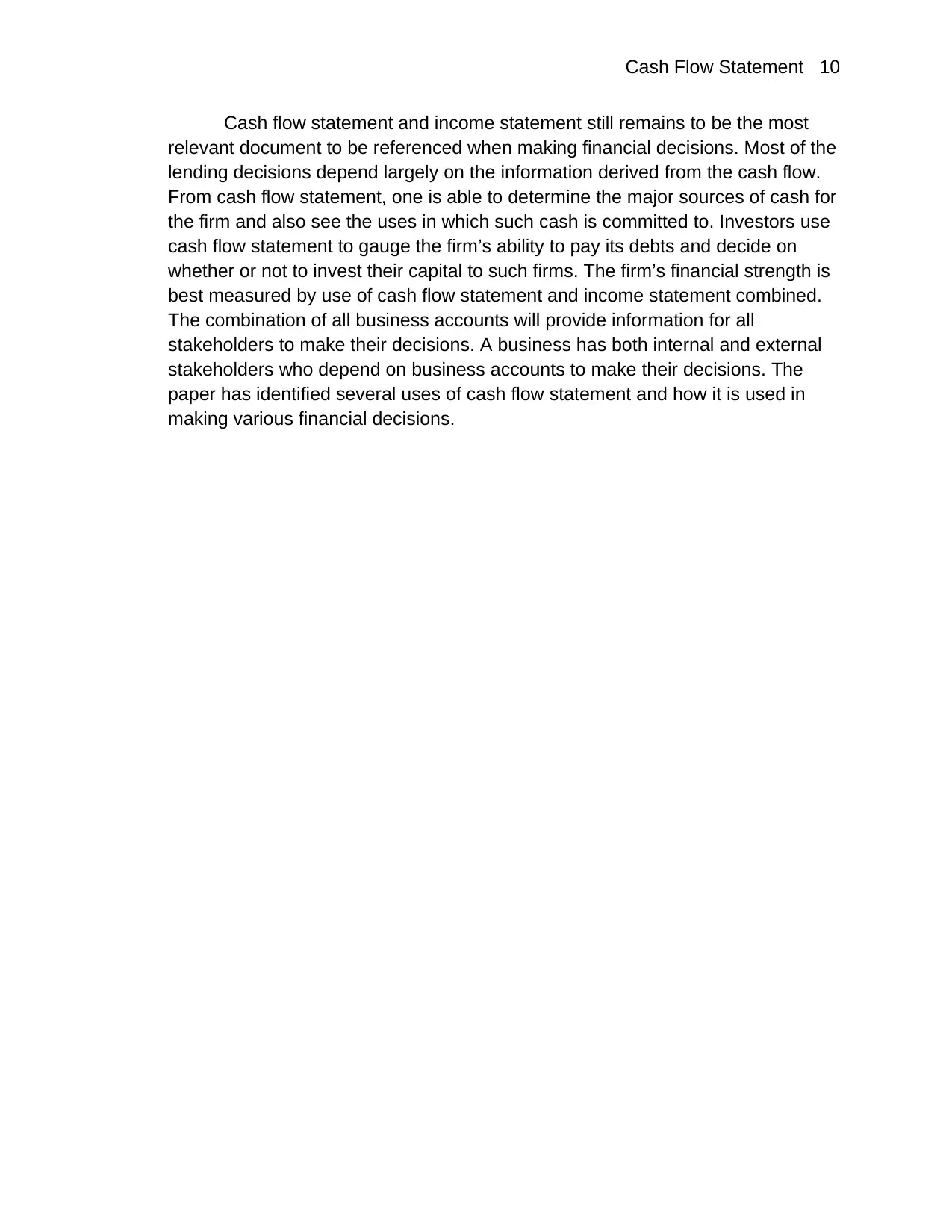
Cash Flow Statement 10
Cash flow statement and income statement still remains to be the most
relevant document to be referenced when making financial decisions. Most of the
lending decisions depend largely on the information derived from the cash flow.
From cash flow statement, one is able to determine the major sources of cash for
the firm and also see the uses in which such cash is committed to. Investors use
cash flow statement to gauge the firm’s ability to pay its debts and decide on
whether or not to invest their capital to such firms. The firm’s financial strength is
best measured by use of cash flow statement and income statement combined.
The combination of all business accounts will provide information for all
stakeholders to make their decisions. A business has both internal and external
stakeholders who depend on business accounts to make their decisions. The
paper has identified several uses of cash flow statement and how it is used in
making various financial decisions.
Cash flow statement and income statement still remains to be the most
relevant document to be referenced when making financial decisions. Most of the
lending decisions depend largely on the information derived from the cash flow.
From cash flow statement, one is able to determine the major sources of cash for
the firm and also see the uses in which such cash is committed to. Investors use
cash flow statement to gauge the firm’s ability to pay its debts and decide on
whether or not to invest their capital to such firms. The firm’s financial strength is
best measured by use of cash flow statement and income statement combined.
The combination of all business accounts will provide information for all
stakeholders to make their decisions. A business has both internal and external
stakeholders who depend on business accounts to make their decisions. The
paper has identified several uses of cash flow statement and how it is used in
making various financial decisions.
Paraphrase This Document
Need a fresh take? Get an instant paraphrase of this document with our AI Paraphraser
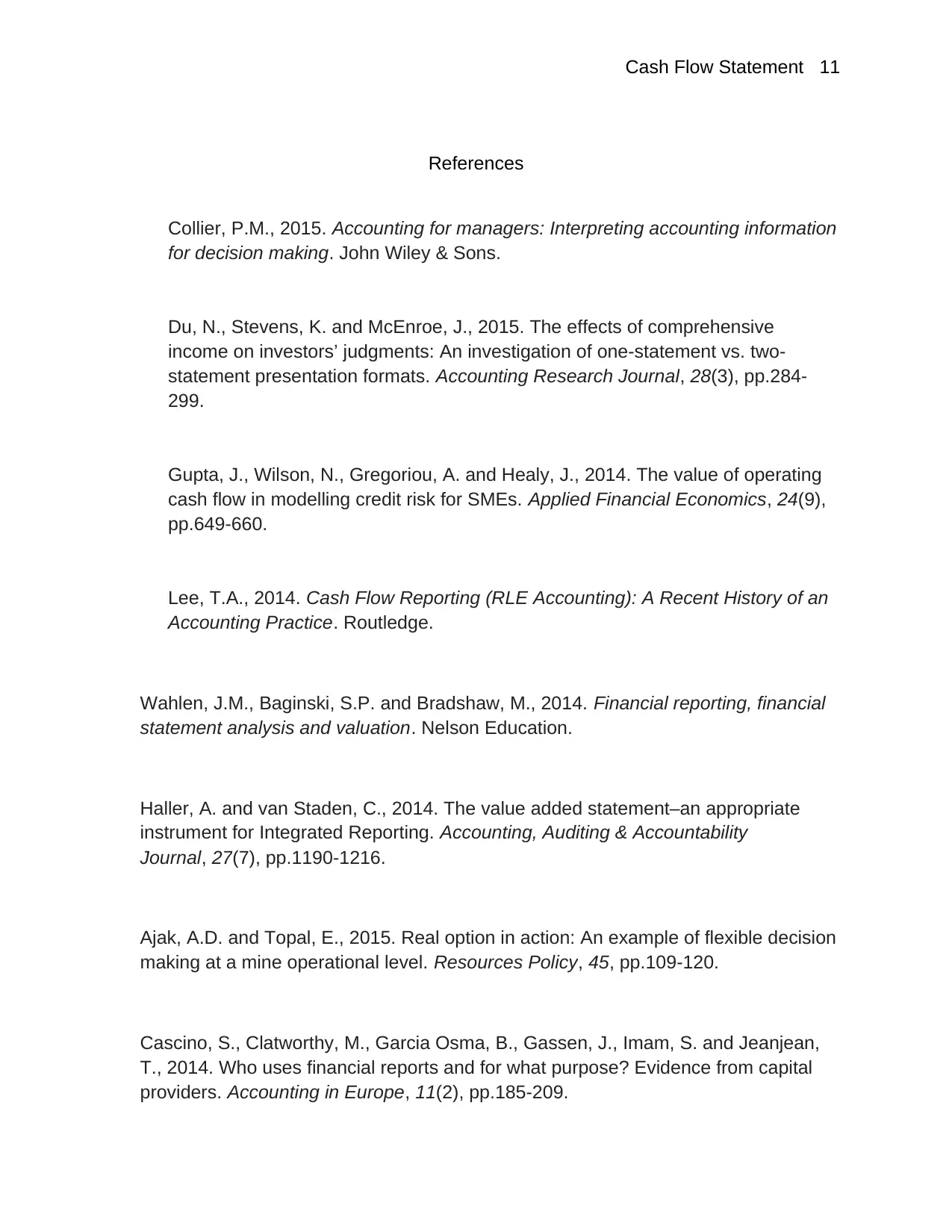
Cash Flow Statement 11
References
Collier, P.M., 2015. Accounting for managers: Interpreting accounting information
for decision making. John Wiley & Sons.
Du, N., Stevens, K. and McEnroe, J., 2015. The effects of comprehensive
income on investors’ judgments: An investigation of one-statement vs. two-
statement presentation formats. Accounting Research Journal, 28(3), pp.284-
299.
Gupta, J., Wilson, N., Gregoriou, A. and Healy, J., 2014. The value of operating
cash flow in modelling credit risk for SMEs. Applied Financial Economics, 24(9),
pp.649-660.
Lee, T.A., 2014. Cash Flow Reporting (RLE Accounting): A Recent History of an
Accounting Practice. Routledge.
Wahlen, J.M., Baginski, S.P. and Bradshaw, M., 2014. Financial reporting, financial
statement analysis and valuation. Nelson Education.
Haller, A. and van Staden, C., 2014. The value added statement–an appropriate
instrument for Integrated Reporting. Accounting, Auditing & Accountability
Journal, 27(7), pp.1190-1216.
Ajak, A.D. and Topal, E., 2015. Real option in action: An example of flexible decision
making at a mine operational level. Resources Policy, 45, pp.109-120.
Cascino, S., Clatworthy, M., Garcia Osma, B., Gassen, J., Imam, S. and Jeanjean,
T., 2014. Who uses financial reports and for what purpose? Evidence from capital
providers. Accounting in Europe, 11(2), pp.185-209.
References
Collier, P.M., 2015. Accounting for managers: Interpreting accounting information
for decision making. John Wiley & Sons.
Du, N., Stevens, K. and McEnroe, J., 2015. The effects of comprehensive
income on investors’ judgments: An investigation of one-statement vs. two-
statement presentation formats. Accounting Research Journal, 28(3), pp.284-
299.
Gupta, J., Wilson, N., Gregoriou, A. and Healy, J., 2014. The value of operating
cash flow in modelling credit risk for SMEs. Applied Financial Economics, 24(9),
pp.649-660.
Lee, T.A., 2014. Cash Flow Reporting (RLE Accounting): A Recent History of an
Accounting Practice. Routledge.
Wahlen, J.M., Baginski, S.P. and Bradshaw, M., 2014. Financial reporting, financial
statement analysis and valuation. Nelson Education.
Haller, A. and van Staden, C., 2014. The value added statement–an appropriate
instrument for Integrated Reporting. Accounting, Auditing & Accountability
Journal, 27(7), pp.1190-1216.
Ajak, A.D. and Topal, E., 2015. Real option in action: An example of flexible decision
making at a mine operational level. Resources Policy, 45, pp.109-120.
Cascino, S., Clatworthy, M., Garcia Osma, B., Gassen, J., Imam, S. and Jeanjean,
T., 2014. Who uses financial reports and for what purpose? Evidence from capital
providers. Accounting in Europe, 11(2), pp.185-209.
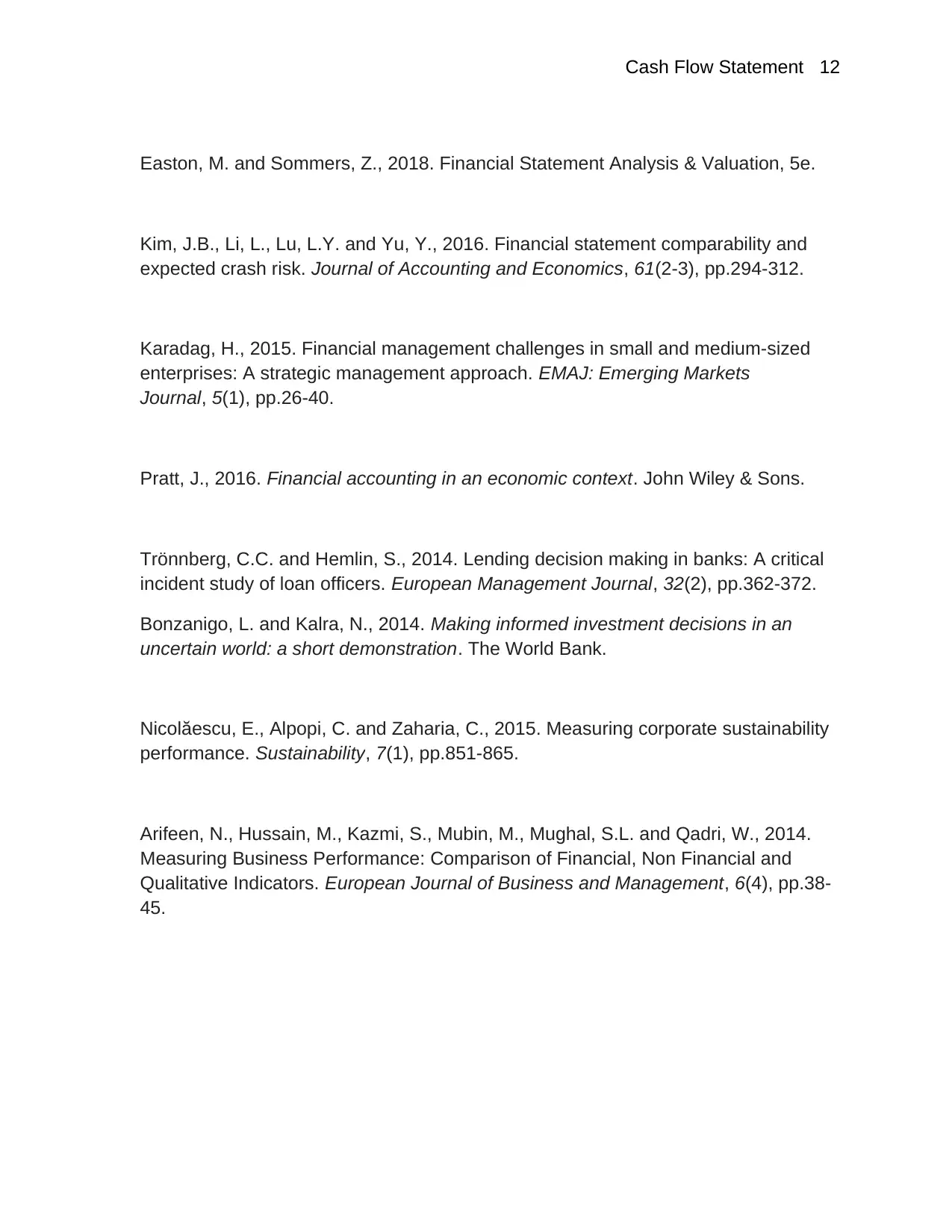
Cash Flow Statement 12
Easton, M. and Sommers, Z., 2018. Financial Statement Analysis & Valuation, 5e.
Kim, J.B., Li, L., Lu, L.Y. and Yu, Y., 2016. Financial statement comparability and
expected crash risk. Journal of Accounting and Economics, 61(2-3), pp.294-312.
Karadag, H., 2015. Financial management challenges in small and medium-sized
enterprises: A strategic management approach. EMAJ: Emerging Markets
Journal, 5(1), pp.26-40.
Pratt, J., 2016. Financial accounting in an economic context. John Wiley & Sons.
Trönnberg, C.C. and Hemlin, S., 2014. Lending decision making in banks: A critical
incident study of loan officers. European Management Journal, 32(2), pp.362-372.
Bonzanigo, L. and Kalra, N., 2014. Making informed investment decisions in an
uncertain world: a short demonstration. The World Bank.
Nicolăescu, E., Alpopi, C. and Zaharia, C., 2015. Measuring corporate sustainability
performance. Sustainability, 7(1), pp.851-865.
Arifeen, N., Hussain, M., Kazmi, S., Mubin, M., Mughal, S.L. and Qadri, W., 2014.
Measuring Business Performance: Comparison of Financial, Non Financial and
Qualitative Indicators. European Journal of Business and Management, 6(4), pp.38-
45.
Easton, M. and Sommers, Z., 2018. Financial Statement Analysis & Valuation, 5e.
Kim, J.B., Li, L., Lu, L.Y. and Yu, Y., 2016. Financial statement comparability and
expected crash risk. Journal of Accounting and Economics, 61(2-3), pp.294-312.
Karadag, H., 2015. Financial management challenges in small and medium-sized
enterprises: A strategic management approach. EMAJ: Emerging Markets
Journal, 5(1), pp.26-40.
Pratt, J., 2016. Financial accounting in an economic context. John Wiley & Sons.
Trönnberg, C.C. and Hemlin, S., 2014. Lending decision making in banks: A critical
incident study of loan officers. European Management Journal, 32(2), pp.362-372.
Bonzanigo, L. and Kalra, N., 2014. Making informed investment decisions in an
uncertain world: a short demonstration. The World Bank.
Nicolăescu, E., Alpopi, C. and Zaharia, C., 2015. Measuring corporate sustainability
performance. Sustainability, 7(1), pp.851-865.
Arifeen, N., Hussain, M., Kazmi, S., Mubin, M., Mughal, S.L. and Qadri, W., 2014.
Measuring Business Performance: Comparison of Financial, Non Financial and
Qualitative Indicators. European Journal of Business and Management, 6(4), pp.38-
45.
⊘ This is a preview!⊘
Do you want full access?
Subscribe today to unlock all pages.

Trusted by 1+ million students worldwide
1 out of 12
Related Documents
Your All-in-One AI-Powered Toolkit for Academic Success.
+13062052269
info@desklib.com
Available 24*7 on WhatsApp / Email
![[object Object]](/_next/static/media/star-bottom.7253800d.svg)
Unlock your academic potential
Copyright © 2020–2025 A2Z Services. All Rights Reserved. Developed and managed by ZUCOL.




